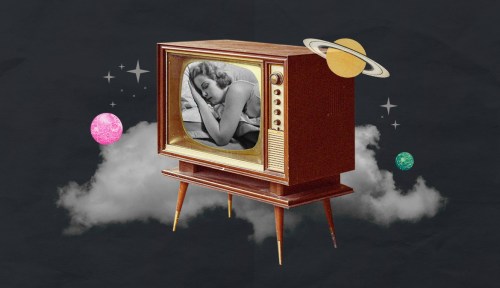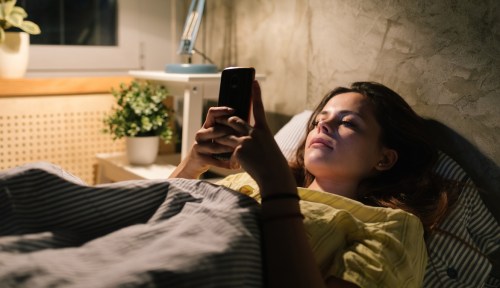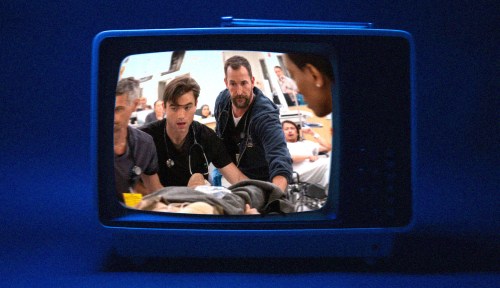Struggling To Fall Asleep? Watching a Video About Space Could Help You Drift Right Off Into the Dreamy Ether
Learn why some people like to use esoteric videos about space and science to calm a racing mind and fall asleep more easily.

As I’m getting ready for sleep, the distant murmur of London traffic is a permanent part of the soundscape in my bedroom. Equally omnipresent is talk of subatomic particles and how the sun will swallow the Earth one day; my partner Luke likes to drift off to sleep amid the sounds of “black hole videos,” or videos about space and science. I found it odd at first, but I’ve come to appreciate the roster of pensive astrophysicists who accompany us to bed. Their engaging narratives and cool graphics transport us to the far reaches of the universe and of human understanding, as we shift into unconsciousness—but above all, says Luke: “They soothe me.”
Experts in This Article
assistant professor of astronomy at Columbia University, head of the Cool Worlds lab, and host of the Cool Worlds YouTube channel
professor in the department of psychiatry at the University of Pennsylvania School of Medicine and director of the Unit for Experimental Psychiatry, Division of Sleep and Chronobiology
registered clinical counsellor with the British Columbia Association of Clinical Counsellors and founder of Lotus Therapy
These black hole videos are from the science channels of YouTube, here to educate and entertain. Luke’s favorite is PBS Space Time, hosted by astrophysicist and king of the jokey science T-shirts Matt O’Dowd (“Heat Death is Coming”). Luke also enjoys History of the Universe (“best for sleeping”), Quanta, Sea Space, Cool Worlds (“the best voice”) and Astrum, which recently launched Sleep Space, a podcast sharing intel about space in a “relaxing way,” geared specifically to all the people who, like Luke, use space videos to fall asleep.
“Intellectually, the universe is an escape—a respite from the constant noise and din of our lives,” says astrophysicist David Kipping, PhD, assistant professor of astronomy at Columbia University, head of the Cool Worlds lab, and host of the aforementioned Cool Worlds YouTube channel. Our lives here on Earth are full of stress—work problems, niggling relationship worries, money troubles, sadness about the state of the world—and it can all come to a head in the form of anxiety as we’re trying to go to sleep. But with a nighttime trip to extrasolar worlds by way of a space video, these Earthly worries can feel less significant.
Dr. Kipping also thinks that pondering space can spark awe, which can soothe a restless mind. As with art, we’re often drawn to questions of philosophy and science without necessarily any “bread-on-the-table functional purpose,” he says. “When we lie on the grass and look up at the stars wondering about their stories, there’s no foreseeable return on that investment.” And when so many of our daily actions are done with particular future-oriented goals in mind, this kind of aimless pondering can be an especially wonderful and relaxing thing, he says.
The existential nature of space videos (Dr. Kipping has been known to ask questions like, Why is something something rather than nothing?) can further stoke our fascination. “Deep down, I think there’s a sense of wonder within us all about these questions,” says Dr. Kipping. “Contemplating the cosmos stirs our imagination, and inspires and elevates our consciousness. It helps give us some context as to what our lives are really all about.” Considering we live in a moment obsessed with productivity and metrics (we’ve even gamified sleep by wearing trackers that tell us if we’ve done a good job sleeping), space videos can provide some much-needed perspective, which can then help us chill out and get some rest.
“Contemplating the cosmos stirs our imagination, and inspires and elevates our consciousness. It helps give us some context as to what our lives are really all about.” —David Kipping, PhD, astrophysicist
“These science shows can really remind us how small we are,” says sleep researcher Mathias Basner, MD, PhD, MSc, director of the University of Pennsylvania School of Medicine’s Unit for Experimental Psychiatry, Division of Sleep and Chronobiology. “[They] basically tell you that the Earth is just a tiny freckle in the universe, and you’re just a tiny freckle on Earth.” Acknowledging that reality can “shift your focus away from everyday anxieties and onto something more expansive,” says registered clinical counsellor Nilou Esmaeilpour, MSc, RCC, founder of Lotus Therapy. “Cosmic events are beyond our control, and accepting that can ease our worries.”
This is especially relevant for people who’ve experienced trauma and who may struggle to practice typical mindfulness exercises to calm their mind before bed, adds Esmaeilpour. “Some people with trauma can find it really hard to sit down and meditate…It can feel threatening to go inside themselves because sitting in silence can bring up disturbing images or thoughts,” she says. “What may be more helpful is to use soothing visuals, which can send a message to their nervous system: ‘You’re okay, you’re safe, and nothing bad is happening.’”
While the general consensus among sleep scientists is that looking at screens in the bedroom before going to sleep is bad (the blue light they emit can be arousing), Dr. Basner caveats that for some people, it’s okay to watch a show before bed if it helps with drifting off. For example, people who live in noisy places often report that a soothing show can help mask unwanted noise and allow them to fall asleep, he says. The important thing is to avoid anything loud or exciting, and make sure to use a timer so it turns off after a while, he adds: “Just like the brain needs to recuperate when we’re sleeping, the auditory system also needs to rest.”
Turning off YouTube auto-play, then, is a must for anyone who uses space videos to fall asleep; you want to watch your selected show and drift off—not worry about what your unconscious mind might absorb from an algorithm left to its own devices. Josh Pudlo, who lives in Connecticut, is especially aware of what he’s absorbing in the moments when he’s not quite awake, but not yet asleep. For him, watching space videos just as he’s falling asleep, while he’s straddling the border between conscious and unconscious, is a part of the appeal: “That’s the moment when your mind seems to be open to the idea of anything and everything being possible; you feel like you’re a part of the universe, of the unknown,” he says.
Josh’s favorite YouTube channel is History of the Universe because of the lengthy, detailed videos. “I’m an extremely vivid dreamer,” says Josh, explaining that watching these videos at bedtime often means he’ll dream about the topics, too. “All of a sudden, I’m traveling across the universe in a dream where there are no laws of physics, so the possibilities are endless,” he says. “Without these videos, my dreams wouldn’t be nearly as expansive and immersive.”
Zac Logsdon, who lives in Oklahoma, began to use space videos to fall asleep after being fed one by the algorithm of his TikTok “For You” page; the app now allows videos to go for as long as 10 minutes, giving physicists like Neil deGrasse Tyson and Brian Cox time to ponder the state of our universe. “I don’t have a long attention span, but I was just so drawn in by it, and now, [TikTok] shows them to me all the time,” says Zac, noting that the accidental discovery has been a boon for his sleep. “I have a difficult time shutting my brain off [at night]…My mind races with all the things I need to be doing or problems I need to solve. But watching videos like these helps me realize the insignificance of everything. It allows me to say to myself, ‘This is not a big deal. You’ve got your health, your kids are healthy, you’ve got a roof over your head—go to sleep.’”
For Luke, space videos have become a refuge from a world where people often pretend to have it all figured out. “We know so little, yet as a species, we walk around with such hubris, [telling each other that] if you follow the rules, life will go well,” he says. But in reality, we have so little control over preventing bad things from happening—a fact we’re often reluctant to acknowledge. “We all have a relationship with chaos, but most people just pretend the chaos doesn’t exist,” says Luke. For him, to watch a video about how the Earth will one day be swallowed up by the sun is to place himself in relation to chaos; it’s a way to face the chaos that’s everywhere, but at a safe distance. (After all, we have hundreds of millions of years left.)
Luke’s favorite nighttime YouTube subject is black holes, which reflect the frontier of order and human knowledge—where the laws of physics break down. “My black hole nighttime video routine lets me approach the horizon of knowability with curiosity, and that is empowering,” he says. Ultimately, we’re at the mercy of everything around us; we matter, yet also, we don’t. “Watching these videos makes me feel in calibration with the universe,” says Luke. And with that, he can relax and fall asleep.
Sign Up for Our Daily Newsletter
Get all the latest in wellness, trends, food, fitness, beauty, and more delivered right to your inbox.
Got it, you've been added to our email list.










